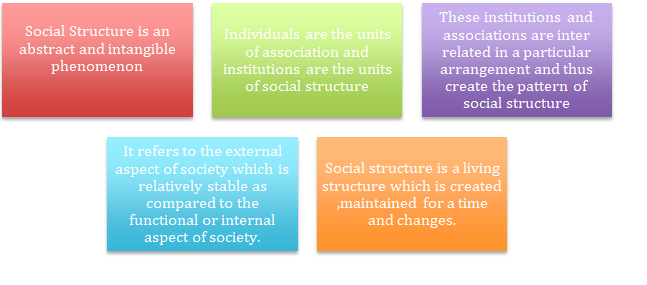Home » Social Structure
Social Structure
Index
- Introduction to Social Structure
- Conceptual Foundations of Social Structure
- Structural Components: Status, Role, Norms, and Institutions
- Early Thinkers and Classical Perspectives
- Structural Functionalism: Talcott Parsons and A. R. Radcliffe-Brown
- Structuralism and Levi-Strauss
- Conflict Theory and Structural Contradictions
- Social Structure and Social Stratification
- Social Structure in Indian Society
- Changing Nature of Social Structure in Contemporary Times
- Critiques and Alternative Perspectives
- Conclusion

1.Introduction to Social Structure
Social structure is one of the most foundational concepts in sociology, serving as the analytical framework through which sociologists understand the patterned relations and enduring institutions that shape individual behaviour and collective life. At its core, social structure refers to the organized pattern of social relationships and social institutions that together compose society. It includes recurrent interactions, hierarchies, norms, roles, and values that become institutionalized over time. Unlike random interactions, social structures are durable and resistant to change, shaping both opportunities and constraints for individuals. While the concept is abstract, it has concrete manifestations in family systems, class hierarchies, political frameworks, and institutional arrangements. The study of social structure is essential for understanding both social stability and the mechanisms through which change occurs.
2.Conceptual Foundations of Social Structure
The term “structure” in sociology derives from architecture, where it denotes an arrangement of parts that create a whole. In the sociological context, social structure is the enduring, orderly, and patterned relationships among elements of society. Social structures are not physical entities but are composed of positions (statuses), relationships (roles), and norms that regulate interactions. They provide the “grammar” of social life—a set of rules and conventions within which individuals act.
Social structure operates at both the macro and micro levels. At the macro level, it encompasses institutions such as the economy, polity, education, and religion. At the micro level, it includes face-to-face interactions and social roles. While individuals operate within the structure, they are also shaped by it. Thus, social structure is both enabling and constraining. It provides the context within which human agency unfolds, and it is reproduced or transformed through human actions.
3.Structural Components: Status, Role, Norms, and Institutions
The building blocks of social structure include statuses, roles, norms, and institutions. A status refers to a recognized social position that an individual occupies (e.g., student, parent, teacher), and each status is associated with a role, which consists of the behaviours expected from someone occupying that status. Norms are the shared expectations and rules that guide behaviour, and institutions are stable clusters of norms and roles that address fundamental social needs (e.g., the institution of family provides socialization, care, and reproduction).
Statuses can be ascribed (inherited) or achieved (earned). These structural positions influence how individuals interact and are treated in society. Social institutions like the legal system or education serve to institutionalize and regulate these statuses and roles, thereby stabilizing the social structure. Understanding these components helps decode the intricate web of relationships that maintain the social fabric
4.Early Thinkers and Classical Perspectives
a.Herbert Spencer
Spencer introduced the idea of society as a social organism, drawing analogies from biology. In his evolutionary framework, societies evolve from simple to complex forms, and their structures evolve accordingly. He saw social structures as differentiated units performing specialized functions, contributing to the survival of the social organism. Spencer’s conception of structure was rooted in evolutionary logic, where complexity and interdependence mark modern societies.
Emile Durkheim
Durkheim offered one of the first systematic treatments of social structure. He conceptualized society as a reality sui generis, meaning that it exists above and beyond individuals. In his work The Division of Labour in Society, he explained how social cohesion was maintained in different types of societies. Mechanical solidarity bound traditional societies together through shared values and beliefs, while organic solidarity in modern societies emerged from functional interdependence. Durkheim’s focus on collective conscience, anomie, and social facts forms a critical foundation for understanding social structure as both coercive and integrative.
Karl Marx
Marx viewed social structure through the lens of materialism and economic determinism. For Marx, the economic base (means and relations of production) determines the superstructure (law, politics, religion, culture). He saw class struggle as the motor of history and as embedded within the structural contradictions of capitalism. The bourgeoisie and proletariat represent structural positions rooted in exploitation and inequality. Marx’s theory remains pivotal in understanding how power, domination, and material conditions shape and are shaped by social structure.
Max Weber
Weber contributed a more interpretive and multidimensional view of social structure. He emphasized the role of ideas, values, and authority in shaping social life. In Economy and Society, Weber classified authority into three types—traditional, charismatic, and rational-legal—each forming a distinct structural arrangement of power. He also introduced the concept of social stratification based on class, status, and party, offering a more nuanced view of inequality than economic determinism. Weber thus moved the study of structure beyond economics to include legitimacy, bureaucracy, and rationality.
5.Structural Functionalism: Talcott Parsons and A. R. Radcliffe-Brown
Structural functionalism reached its apex in the mid-20th century with
Talcott Parsons and A. R. Radcliffe-Brown.
Parsons saw society as a system of interrelated parts, each performing a
function to maintain the whole. His AGIL model—Adaptation, Goal
Attainment, Integration, and Latency—identified four functional
prerequisites that all social systems must meet. Institutions like the family,
education, and religion were seen as specialized organs within this
structural system. Parsons emphasized value consensus as the glue
holding society together.
Radcliffe-Brown, working in the British anthropological tradition, viewed social structure as the “arrangement of persons in institutionalized roles.” For him, kinship systems, rituals, and tribal norms all contributed to the maintenance of social order. His structural-functional approach emphasized the synchronic analysis of social institutions, i.e., understanding how structures operate at a given point in time to maintain equilibrium.
6.Structuralism and Levi-Strauss
Claude Levi-Strauss applied structuralist theory to culture, language, and kinship. Influenced by linguistics, he argued that underlying universal structures governed human culture, just as grammar governs language. In kinship, for instance, he found binary oppositions (e.g., wife-givers vs. wife-takers) that structured relationships. Structuralism focused less on individual behaviour and more on the deep structures of cognition and symbolic systems. While abstract, his approach highlighted how even the most diverse societies could be analyzed using common structural principles.
7.Conflict Theory and Structural Contradictions
Unlike the consensus view of structural functionalism, conflict theory argues that social structures are marked by inequality and struggle. Inspired by Marx, neo-Marxist thinkers like Antonio Gramsci and Louis Althusser emphasized how ideological and state apparatuses reproduce structural domination. Structural contradictions—such as those between capital and labour—generate tension, resistance, and change.
Feminist theorists also critique the patriarchal structure of society, arguing that gender is embedded in institutions and norms. They show how social structures systematically disadvantage women through roles, laws, and expectations. Similarly, postcolonial theorists argue that colonial social structures continue to shape global inequalities. These perspectives demonstrate that structure is not always integrative—it can be exclusionary and oppressive.
8.Social Structure and Social Stratification
Social structure is closely linked to stratification, the hierarchical arrangement of individuals and groups in society. Stratification systems—like caste, class, race, and gender—are embedded in structural arrangements. They determine access to resources, power, and life chances.
Caste, for instance, is a deeply rooted social structure in Indian society, historically based on ritual purity and occupational hierarchy. Class systems, in contrast, are based more on economic status and mobility. However, both forms of stratification become institutionalized, shaping identities, interactions, and expectations. Understanding the structural basis of stratification is crucial for analyzing inequality and social mobility.
9.Social Structure in Indian Society
The Indian social structure is shaped by a unique interplay of caste, religion, kinship, and regional diversities. The varna-jati hierarchy, joint family system, and patriarchal norms form key elements of traditional structure. Pioneering Indian sociologists like G. S. Ghurye, M. N. Srinivas, and Andre Béteille analyzed these features in depth.
Srinivas introduced the concepts of Sanskritization and Dominant Caste, which show how the caste structure evolves and adapts to socio-economic change. Béteille emphasized the distinction between structure and ideology, arguing that while democratic ideals promote equality, structural realities often reproduce inequality. The Indian context shows how enduring structures like caste can coexist with modern institutions like democracy, capitalism, and education—sometimes reinforcing, sometimes challenging one another.
10.Changing Nature of Social Structure in Contemporary Times
In the contemporary era, social structures are undergoing rapid transformation due to globalization, digitalization, urbanization, and changing family forms. Traditional roles and norms are being redefined, institutions are becoming more flexible, and identities are increasingly fluid. Yet, structural inequalities persist, albeit in new forms. For instance, the gig economy has created new forms of labour stratification, while social media has restructured communication and public discourse.
Global migration has also altered the demographic and cultural composition of societies, challenging existing structural arrangements. Hybrid identities, transnational families, and diasporic communities are becoming new structural phenomena. These changes demand a dynamic understanding of social structure—one that is historically grounded yet open to contemporary realities.
11.Critiques and Alternative Perspectives
Several critiques have emerged against rigid and deterministic notions of social structure. Symbolic interactionists argue that structure cannot be understood without examining micro-level interactions. Postmodernists reject the idea of grand structural totalities altogether, emphasizing fragmentation, difference, and plurality.
Anthony Giddens, in his theory of structuration, attempts to bridge structure and agency. He argues that structures are both the medium and the outcome of social practices—they constrain and enable actions, but are also reproduced and transformed by them. This duality challenges both structural determinism and voluntarism.
Feminist, postcolonial, and indigenous scholars have pushed for more inclusive and intersectional understandings of social structure, drawing attention to voices and experiences excluded from traditional theories.
12.Conclusion
The concept of social structure remains central to the sociological imagination. It helps us understand how society is organized, how roles and institutions function, and how inequality is reproduced or challenged. From classical theories to contemporary critiques, the study of social structure offers a powerful lens for examining the complexities of social life. Whether through the solidarity of Durkheim, the contradictions of Marx, or the functional interdependence of Parsons, each perspective contributes to a fuller understanding of the patterned and enduring nature of human societies. As the world continues to evolve, sociologists must refine and expand the concept of social structure to capture new forms of organization, inequality, and resistance.
References
- Durkheim, E. (1893). The Division of Labour in Society. New York: Free Press.
- Parsons, T. (1951). The Social System. Glencoe: Free Press
- Marx, K. (1867). Capital: A Critique of Political Economy.
- Weber, M. (1922). Economy and Society.
- Spencer, H. (1876). The Principles of Sociology
- Levi-Strauss, C. (1969). The Elementary Structures of Kinship. Beacon Press.
- Giddens, A. (1984). The Constitution of Society. Polity Press.
- Srinivas, M. N. (1966). Social Change in Modern India. University of California Press.
- Béteille, A. (1965). Caste, Class and Power: Changing Patterns of Stratification in a Tanjore Village.
The term structure refers to some sort of ordered arrangement of parts or components. A musical composition has a structure; a sentence has a structure etc. In all these we find an ordered arrangement of different parts. A structure can be called a building only when these parts or components are arranged in relationship with the other. In the same manner society has its own structure called social structure. The components or units of social structure are persons. A person is a human being that occupies position in a social structure. Even though the persons are subject to change the structure as such maintains its continuity. A nation, tribe, a political party, a religious body can continue in existence as an arrangement of persons though the personnel of each changes from time to time. There is continuity of structure just as a human body maintains its structure. Sociologists speak of few kinds of structures or groups that will be present in all societies. These structures will exist in any society regardless of its ethos, history or any cultural variability. Because without the functions of these structures a human society cannot survive. Thus a family may be monogamous or polygamous; a government may be democratic or authoritarian; an economy may be socialist or capitalist. The nature of the specific structure may vary from society to society but there always be a structure resulting in a function.
Social Structure Definition
The concept of social structure has been defined in different ways by different thinkers and sociologists. Herbert Spencer was the first thinker who wrote about structure of a society. He came up with biological analogies (organic structure and evolution) to define the social structure.
According to Radcliff-Brown social structure is a part of the social structure of all social relations of person to person. In the study of social structure the concrete reality with which we are concerned is the set of actually existing relations at a given moment of time that link together certain human beings.
A more general definition of social structure is that social structure refers to the enduring orderly and patterned relationships between the elements of a society. According to Raymond Firth it makes no distinction between the ephemeral and the most enduring elements in social activity and it makes it almost impossible to distinguish the idea of the structure of society from that of the totality of the society itself.
According to S.F Nadal structure refers to a definable articulation and ordered arrangement of parts. It is related to the outer aspect or the framework of society and is totally unconcerned with the functional aspect of society. So he has emphasized that the social structure refers to the network of social relationship that is created among the human beings when they interact with each other according to their statuses in accordance with the patterns of society. He has emphasized that the social structure refers to the network of social relationship that is created among the human beings when they interact with each other according to their statuses in accordance with the patterns of society.
According to Ginsberg the study of social structure is concerned with the principal form of social organization that is types of groups, associations and institutions and the complex of these that constitute societies.
According to Karl Mannheim social structure refers to the web of interacting social forces from which have arisen the various modes of observing and thinking. Social structure is an abstract and intangible phenomenon Individuals is the units of association and institutions are the units of social structure. These institutions and associations are inter-related in a particular arrangement and thus create the pattern of social structure. It refers to the external aspect of society that is relatively stable as compared to the functional or internal aspect of society. Social structure is a living structure that is created, maintained for a time and changes.
According to Talcott Parsons, the term social structure applies to the particular arrangement of the interrelated institutions, agencies and social patterns as well as the statuses and roles which each person assumes in the group. Parsons has tried to explain the concept of social structure in abstract form. All the units of social structure that is institutions, agencies, social patterns, statuses and roles are invisible and intangible and hence are abstract. According to Maclver and Page the various modes of grouping together comprise the complex pattern of the social structure. They have also regarded that social structure is abstract which is composed of several groups like family, church, class, caste, state or community etc.
According to Johnson, the structure of anything consists of the relatively stable inter-relationships among its parts; the term part itself implies a certain degree of stability. Since a social system is composed of the inter-related acts of people, its structure must be sought in some degree of regularity or recurrence in these acts.
What is Social Structure in Sociology?
On the basis of the definitions social structure can be understood in the following points

|
|
Notes on Concepts of Social Structure
- Perspectives on Social Structure
- Elements of Social Structure
- Structuralism
- Formal and Informal Structure
- Types of Social Structure
- Social Structure and Social Organization
- Social Structure and Role
- Important Terms

 |
© 2025 sociologyguide |
 |













